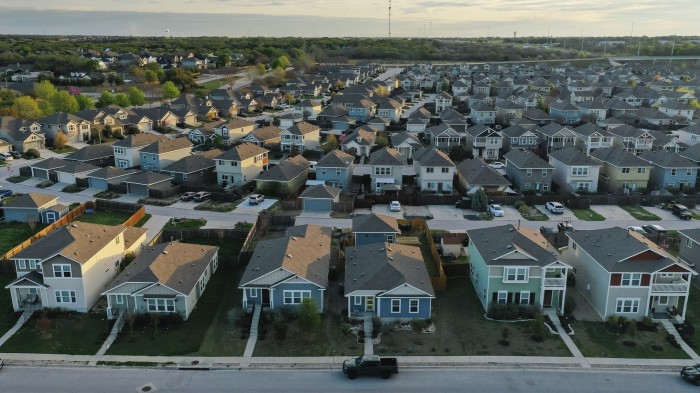Americas are giving up on the dream of owning a “McMansion” as ever higher prices force them to seek out smaller dwellings.
The size of the average home for sale in the US declined to 1,800 sq ft in March, down 7 per cent from March 2020, according to data from Realtor.com and the Federal Reserve Bank of St Louis.
The size of the average US home under construction dropped in 2024 to the lowest level since 2010, according to the US Census Bureau.
Buffeted by high interest rates, rising insurance and regulatory restrictions, the cost of a new home has soared in many parts of the US. The number of renters who can afford a new home has been cut in half. Some homebuilding companies have been forced to aggressively subsidise mortgage costs to attract buyers.
President Donald Trump’s trade wars could present a new headwind for the market if the price of lumber, copper and other building materials shoot higher. The US imports about 25 to 30 per cent of lumber needed for housing from Canada, and lumber prices are already up about 16 per cent so far this year, according to a March report from Morningstar.
These cost concerns mean demand for small homes on small lots — well known throughout Japan — is catching on in the US.
In Texas, a state not known for modest proportions, lawmakers are trying to roll back laws requiring minimum lot sizes to allow for smaller home construction. Dan Patrick, the lieutenant-governor of Texas, has backed the proposal, noting the median Texas home price surged 40 per cent to $335,000 from 2019 to 2023.
“The new build [houses], they are being built on these very narrow lots with only space for one car,” said Laura Ponce, executive director of Project Bravo, a social services non-profit in El Paso, Texas. “Families are having to double up or triple up to buy a home,” she said. That meant “everyone of working age has to sign on as purchasing these homes,” including adult children.
As the Covid-19 pandemic fades into history, so too has Americans’ demand for in-home gyms and offices. Now, garages might be scrapped altogether.
“It is largely because of affordability,” said Ali Wolf, chief economist at Zonda, a housing research firm. “It is a structural shift where we will see smaller homes.”
Yet as homes shrink, they are “not necessarily cheaper, just given the fact that [construction] costs have gone up so much across the board,” she said.
Comprising about 4 per cent of US GDP, home construction and remodelling have been hit hard by the Federal Reserve’s decision to keep interest rates higher for longer. While mortgage rates have edged down in recent months, the average 30-year mortgage was 6.67 per cent this month, a rate not seen since 2008, according to Freddie Mac.
Only about 20 per cent of US renters can afford that mortgage rate plus the 20 per cent down payment typically needed to buy a home, according to the National Association of Realtors. That is down from 42 per cent of renters in 2019 when mortgage rates were about 3.9 per cent and home prices were roughly 30 per cent lower.
The affordability challenges have stung US homebuilders. Share prices of DR Horton, Lennar, Toll Brothers have dropped between 27 and 33 per cent over the past 12 months. In that time, The S&P 500 index decreased 4 per cent.

Generally, larger homes offer builders higher profit margins, said Tony Avila, founder and CEO of the Builder Advisor Group. “I would expect the margins might be slightly lower with a smaller square foot [home].”
DR Horton, the largest US homebuilder by volume, said in February that its December sales of duplexes and town houses hit the highest level in about 20 years.
“Most people, if they can afford it, would like to be in a single-family detached home. But if they can’t, they can get into a town home,” Jessica Hansen, a senior vice-president at DR Horton, said at a conference in February.
She added that the company has introduced a “cottage” home that is only about 1,000 to 1,200 square feet and “probably a one-car or no-car garage”.
The average size of a single-family home isn’t going to drop from 1,950 square feet to 1,500 “overnight,” Hansen said. “But we do build floor plans that are roughly 1,500, 1,600 square feet that are very liveable as a single-family detached house,” she said.
As the Texas housing legislation works through the state capital, other states are grappling with regulatory challenges that might unlock affordable housing.
Manufactured and prefabricated homes, which differ from homes built on-site from the ground up, can be an affordable option for some buyers, said Getchen Raad, a realtor with Berkshire Hathaway in Lancaster, Pennsylvania.
“A lot of these zoning and land use restrictions and regulations do not allow manufactured housing,” she said. “Could that be a potential option from an affordability standpoint? Absolutely, but definitely a lot of municipal [regulatory] changes would need to happen.”
Previous efforts to shrink lot sizes for smaller homes have been opposed in wealthy neighbourhoods, Avila said.
Residents have argued, “we don’t want cheap houses, that’s going to lower the average sales price of all the houses that are already here”, Avila said.
https://www.ft.com/content/310a2d31-3afd-492c-b674-07d06db70338


